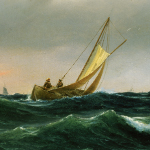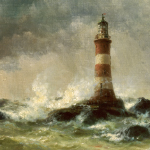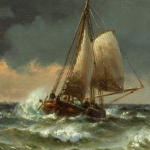
Vilhelm Melbye was born in 1824 in the harbour town of Helsingør. Having completed his commercial training in London, he turned to the arts and, guided by his brother Anton, specialized on painting seascapes. He was the only one of the three brothers to study at the Academy of Fine Arts in Copenhagen from 1844 to 1847 and to take lessons on perspective from Carl Dahl.
In 1847, Vilhelm Melbye successfully debuted at the Academy’s spring exhibition. In the same year, he accompanied the Danish Navy to Iceland and discovered the rough North Sea as a motif. He was one of the first Danish artists to travel to the northern tip of Denmark in the 1840s before the artists' colony of Skagen painters was founded there in the 1870s / 80s. It was the Danish coastlines in particular that provided Vilhelm Melbye with motifs for his plein air oil studies and for his studio work painted with fine brushes.

His brothers Anton and Fritz Melbye having previously left Denmark, Vilhelm Melbye too set off on a study trip in 1851. After a short stay in Hamburg and a brief interlude in Dusseldorf, he moved to Paris where he exhibited work from a collaboration with Carl Dahl in 1852.
That same year, he travelled to London. For the next 14 years, the British capital became his home and a significant base for his artistic career. Here, Vilhelm Melbye regularly held exhibitions, acquired his own circle of collectors, and a firm place in English maritime painting. In 1856, the Danish king acquired a painting of Fingal’s Cave in Scotland.
Vilhelm went on excursions to the coasts of England and Scotland, alternating them with home stays and longer trips through Europe, which took him to France, Spain, Gibraltar, Italy, Holland and Switzerland.

In 1854, Vilhelm Melbye married Nanny Matthison-Hansen, daughter of the composer and cathedral organist Hans Matthison-Hansen in Roskilde. The couple adopted her daughter Minna in 1857. In 1867, the family left England and returned permanently to Denmark, where they moved to Roskilde on the Roskildefjord, about 30 km west of Copenhagen.
Melbye regularly displayed his work in the exhibitions of Copenhagen’s art academy. In 1873 and 1878, he took part in the world exhibitions in Vienna and Paris. Already during his studies Vilhelm Melbye established and maintained contacts with Sweden and Norway, where his works were shown and bought at exhibitions. His travels to the Norwegian fjords inspired him to paint the pristine mountain scenery. The harsh northwest coast of Jutland was also one of Melbye’s favourite destinations.
However, the artist did not gain official recognition until the 1870ies: in 1871, Vilhelm Melbye was accepted as a member of the Copenhagen Academy of Arts and in 1880 he was appointed as a professor. In 1876, he received the Order of Dannebrog. Vilhelm Melbye died in October 1882.
were detected by an English art critic in 1876 in the carefully observed consistency and mobility of the sea in Vilhelm Melbye’s "water-paintings". This comment represents the high esteem the Danish artist won in the art scene in Victorian England to which the navy had a great appeal. In the shadow of his older brother Anton, Vilhelm Melbye developed his own distinctive artistic style as a painter of seascapes and an own circle of collectors, mainly in England, Denmark and Scandinavia.
Vilhelm Melbye took artistic inspiration not only from the Copenhagen Academy of Fine Arts and from his older brother, but also from Dutch, French and English maritime painting. Throughout his life, he had the habit of keeping his impressions of his extensive journeys in Europe and his home country, and detailed observations of nature, alive in oil sketches en pleine air and in pencil sketches. They led him to produce atmospheric lively paintings of a great variety of genres set in nature and filled with light for which Melbye used both a delicate, light range of colours as well as strong dark colours.
As a motif, he preferred scenic and spectacular coastlines, ship traffic on the high seas in stormy weather and picturesque, topographical European landscapes. Stand-alone drawings by Vilhelm Melbye are rather rare. In addition to the finely painted works, Melbye started producing paintings in which he detached himself from the academic style of painting and instead captured dynamic impressions of untamed nature with fast and sweeping strokes with broad brushes.
Picture excerpts Life stations
1) Vilhelm Melbye, Selger vor Kullen, 1848 (private collection)
2) Vilhelm Melbye, Der Leuchtturm, 1866 (private collection)
3) Vilhelm Melbye, Einfahrt im Sturm, 1879 (private collection)
Detail
Carte de Visite, Fotografie von Vilhelm Melbye, o.Dt. (nach 1863), Fotograf Georg Rosenkilde (Kongelige Bibliotek, Copenhagen)